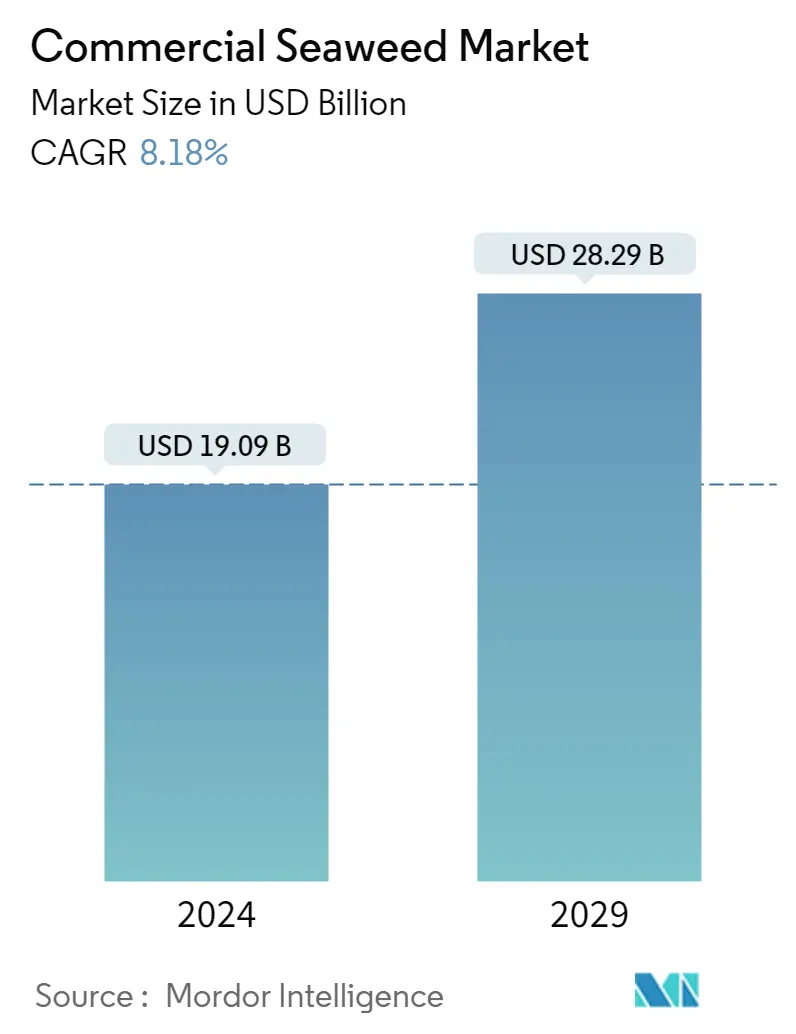Market Size of Commercial Seaweed Industry

| Study Period | 2019 - 2029 |
| Market Size (2024) | USD 19.09 Billion |
| Market Size (2029) | USD 28.29 Billion |
| CAGR (2024 - 2029) | 8.18 % |
| Fastest Growing Market | North America |
| Largest Market | Asia Pacific |
Major Players
*Disclaimer: Major Players sorted in no particular order |
Commercial Seaweed Market Analysis
The Commercial Seaweed Market size is estimated at USD 19.09 billion in 2024, and is expected to reach USD 28.29 billion by 2029, growing at a CAGR of 8.18% during the forecast period (2024-2029).
- The functional and healthy properties of edible seaweed drive the commercial seaweed market. Most of the commercially produced seaweed is used in the food industry. Globally, seaweeds are gaining popularity as part of the staple diet, food flavor enhancers, and nutritious food items, as well as for their weight loss properties. Due to their anti-microbial qualities, which aid in food preservation, seaweeds are utilized as ingredients or eaten as foods.
- Also, Seaweed contains a good amount of Iodine which is rarely found in food ingredients. While controlling the amount of estrogen and estradiol in the human body is also essential. Making anti-obesity foods is made easier by using seaweed, and its isolates tend to promote satiety while reducing postprandial glucose and lipid absorption rates in humans.
- Being resource-neutral, seaweed farming can use something other than land, fresh water, fertilizers, or pesticides. It mitigates the negative consequences of climate change by sequestering CO2. It is a booming sector that serves the needs of food, feed, pharmaceutical, cosmetic, biofuel, biofertilizer, and other industries. The bio-stimulants in seaweed extracts protect against biotic stress and increase crop output. The underlying opportunity areas are for animal and human nutrition products to boost immunity and production.
- Further, many recognized organizations in the healthcare sector, such as the World Health Organization, have stated that seaweed has the potential to fight coronavirus. This factor has changed the consumers' perception of seaweed and increased its demand simultaneously.
Commercial Seaweed Industry Segmentation
Seaweeds are a group of photosynthetic, non-flowering, plant-like organisms (called microalgae) that live in the sea.
The market is segmented by product type, application, and geography. By product type, the market is segmented into Red, Brown, and Green Seaweed. Based on application, the market is segmented into food and beverage (hydrocolloids, thickeners, gelling agents, ice-cream stabilizers, and others), dietary supplements, pharmaceutical and medical, and other applications. Based on geography, the market includes major geographies across the region, North America, Europe, Asia-Pacific, South America, the Middle East, and Africa.
For each segment, the market sizing and forecast have been done based on the value (in USD million).
| Product Type | |
| Brown Seaweed | |
| Green Seaweed | |
| Red Seaweed |
| Application | |
| Food and Beverages | |
| Dietary Supplements | |
| Pharmaceuticals | |
| Other Applications |
| Geography | |||||||||
| |||||||||
| |||||||||
| |||||||||
| |||||||||
|
Commercial Seaweed Market Size Summary
The commercial seaweed market is experiencing significant growth, driven by its functional and health benefits, particularly in the food industry. Seaweed is increasingly recognized as a staple diet component, food flavor enhancer, and nutritious food item, valued for its weight loss and antimicrobial properties. Its ability to preserve food and its rich iodine content make it a desirable ingredient. Seaweed farming is environmentally sustainable, requiring no land, fresh water, or fertilizers, and it plays a role in mitigating climate change by sequestering CO2. The market is expanding across various sectors, including food, feed, pharmaceuticals, cosmetics, and biofuels, with seaweed extracts offering bio-stimulant properties that enhance crop yield and protect against biotic stress. The healthcare sector's recognition of seaweed's potential health benefits, including its role in boosting immunity and its use in dietary supplements, is further propelling market demand.
Asia-Pacific holds the largest share of the commercial seaweed market, with China leading in production, followed by South Korea and Japan. The region's high population and increasing consumer awareness contribute to the rising demand for seaweed. Seaweed's health benefits, such as its anti-inflammatory and antioxidant properties, along with its rich content of essential fatty acids and amino acids, drive its popularity in Asia. The market is competitive, with major players like Cargill Inc., DuPont, and Acadian Seaplants Limited employing strategies like mergers and acquisitions to strengthen their market position. Innovations such as the CadalminTM LivCure extract and Cargill's WavePure® range highlight the ongoing development in seaweed-based products, catering to health and food industries globally.
Commercial Seaweed Market Size - Table of Contents
-
1. MARKET DYNAMICS
-
1.1 Market Drivers
-
1.2 Market Restraints
-
1.3 Porter's Five Forces Analysis
-
1.3.1 Threat of New Entrants
-
1.3.2 Bargaining Power of Buyers/Consumers
-
1.3.3 Bargaining Power of Suppliers
-
1.3.4 Threat of Substitute Products
-
1.3.5 Intensity of Competitive Rivalry
-
-
-
2. MARKET SEGMENTATION
-
2.1 Product Type
-
2.1.1 Brown Seaweed
-
2.1.2 Green Seaweed
-
2.1.3 Red Seaweed
-
-
2.2 Application
-
2.2.1 Food and Beverages
-
2.2.2 Dietary Supplements
-
2.2.3 Pharmaceuticals
-
2.2.4 Other Applications
-
-
2.3 Geography
-
2.3.1 North America
-
2.3.1.1 United States
-
2.3.1.2 Canada
-
2.3.1.3 Mexico
-
2.3.1.4 Rest of North America
-
-
2.3.2 Europe
-
2.3.2.1 Germany
-
2.3.2.2 United Kingdom
-
2.3.2.3 France
-
2.3.2.4 Spain
-
2.3.2.5 Russia
-
2.3.2.6 Italy
-
2.3.2.7 Rest of Europe
-
-
2.3.3 Asia-Pacific
-
2.3.3.1 China
-
2.3.3.2 India
-
2.3.3.3 Japan
-
2.3.3.4 Australia
-
2.3.3.5 Rest of Asia-Pacific
-
-
2.3.4 South America
-
2.3.4.1 Brazil
-
2.3.4.2 Argentina
-
2.3.4.3 Rest of South America
-
-
2.3.5 Middle-East and Africa
-
2.3.5.1 United Arab Emirates
-
2.3.5.2 South Africa
-
2.3.5.3 Rest Middle-East and Africa
-
-
-
Commercial Seaweed Market Size FAQs
How big is the Commercial Seaweed Market?
The Commercial Seaweed Market size is expected to reach USD 19.09 billion in 2024 and grow at a CAGR of 8.18% to reach USD 28.29 billion by 2029.
What is the current Commercial Seaweed Market size?
In 2024, the Commercial Seaweed Market size is expected to reach USD 19.09 billion.

